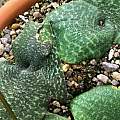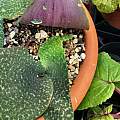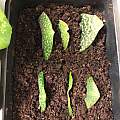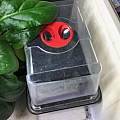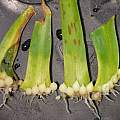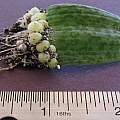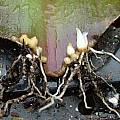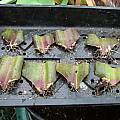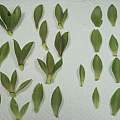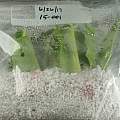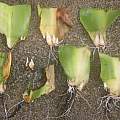Leaf cuttings are a low cost and productive way of generating new bulbs. The technique can be applied to genera including Begonia, Eucomis, Hyacinthus, Lachenalia, Muscari and Resnova. The article below explains the details.
Click here to see PBS list postings about leaf cuttings.
Photos 1-4 from Rimmer de Vries show the process for Resnova megaphylla. He recommends to "take cuttings early in the season from large leaves". For more details see his PBS list post. Photo 5 from Colin Davis shows the results for Lachenalia quadricolor and photo 6 from Pamela Slate for Lachenalia viridiflora.
Photos from Brian Whyer of Eucomis leaf cuttings.
Leaf Cuttings method for Eucomis
This wiki article is based wholly on the PBS list post Leaf Cuttings for Eucomis Props by PBS member Robert Lauf (Tue, 18 May 2021.)
Robert explains that the following is the propagation method of choice for his new Eucomis releases: "Allow me to summarize a few tidbits from personal experience." This is his post, in his words:
- Harvest a leaf in mid-summer. If necessary, water the plant well the night before, so the tissue is as well hydrated as possible.
- Use a new razor blade so you can cut the sections with very little tissue damage.
- Cut the leaf into transverse sections 2-3" long, making the bottom into a V shape. This is because the leaf is much thicker at the midrib than at the edges, and it's easier to push into the growing medium without the thin edges extending all the way down. It also creates more active area for sprouting.
- Stand all the cuttings in a cup of water with Dip-n-Grow at 10:1 dilution and let them soak for a few minutes.
- Plant in promix or perlite making sure the entire cut surface is buried. Keep moist. In promix the pot/flat can stay on the floor of the greenhouse. In perlite, I put the whole thing in either a large plastic bag or a clear leftover container.
Note that I prefer the dip solution over Clonex gel, but both can work OK. Some growers don't use hormone at all and it seems to work. Clonex is my weapon of choice for woody plant cuttings.
Lately I have tended to use the little leaves at the top of the inflorescence (the "pineapple" so to speak) rather than slices off the main leaves, for several reasons:
- If one of the large slices gets rot, you lose the whole thing, whereas with the top leaves, you have dozens of individual leaves and if one rots you haven't lost much.
- You can use a 24-cell tray insert and put one leaf in each, saving yourself the first thinning/transplanting.
The most important things are good hydration of the plant ahead of time, and a really sharp blade. Then, keeping an eye on humidity and avoiding rot.
Images by Robert Lauf:
